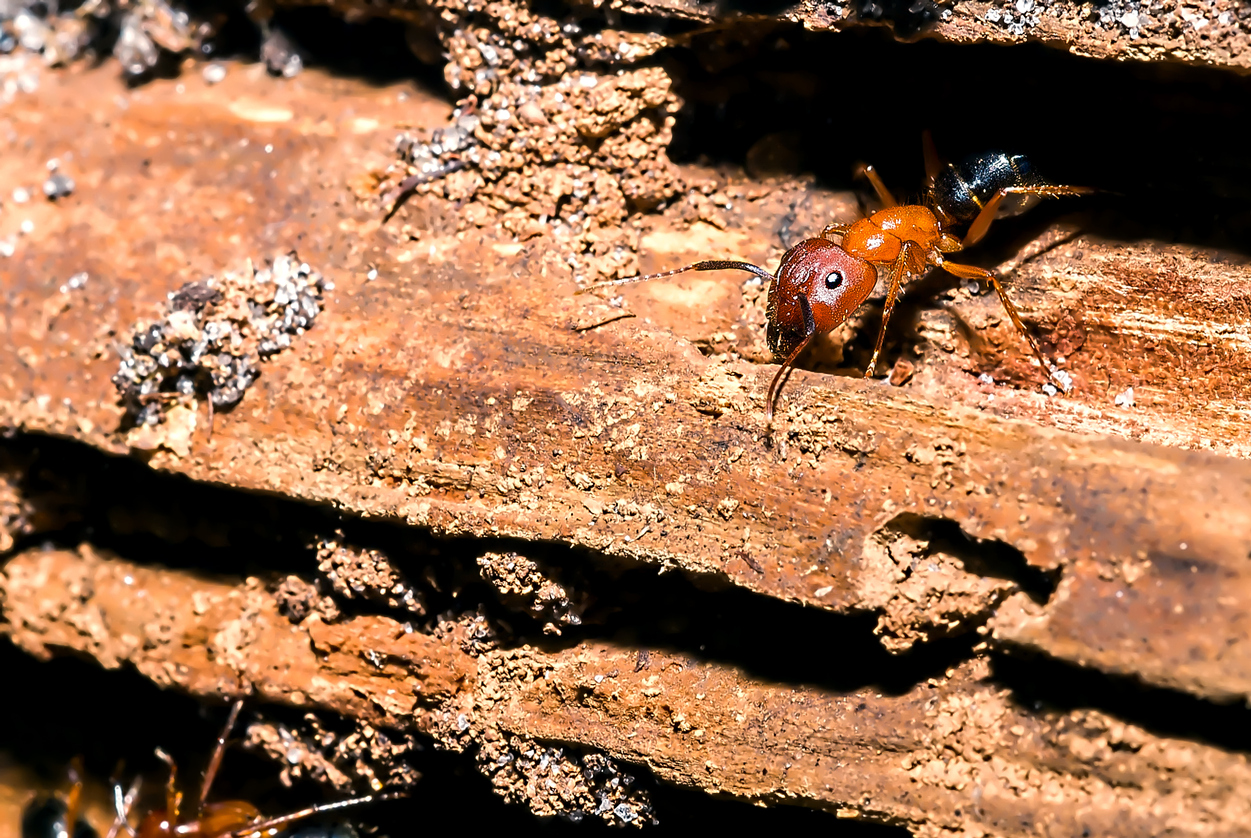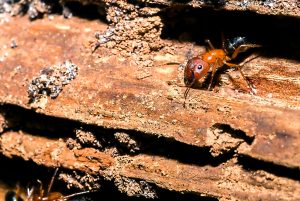As a homeowner, the thought of dealing with a pest infestation may be concerning, but have you considered the damage that specific pests like carpenter ants can cause? Carpenter ants are notorious for burrowing through wooden structures, creating a network of tunnels and galleries, which can lead to structural damage and costly repairs.
Carpenter ants are among the largest and most common ants found in North America. Contrary to common belief, they do not eat wood like termites. Instead, they excavate wood to create their nests, weakening your property’s structural integrity. They are typically dark-colored, ranging from black to brownish-red, with the size of a worker ant varying between 1/4” to 1/2” in length. One obvious sign of carpenter ant infestation is spotting worker ants or winged reproductive ants (swarmers) in or around your home. you can read our latest post on Infestation Signs of Carpenter Ants in House?
Recognizing early signs of carpenter ants is crucial in mitigating damage to your property. Some indicators of their presence include:
- Sightings of worker ants or swarmers occur regularly in your home.
- Faint rustling noises in your walls or wooden structures, can be caused by ants moving inside the wood.
- Piles of wood shavings or “frass” beneath wooden areas indicate excavation activities.
By identifying a carpenter ant infestation, you can take prompt action to prevent further damage to your home. In this guide, we’ll explore essential prevention measures that homeowners should employ and discuss various control methods that can be applied to combat active infestations. Our expert guidance lets you keep your home safe from these destructive pests and maintain your property’s structural integrity.

Carpenter Ant Prevention Strategies
Preventing carpenter ant infestations in your home is the most effective way to protect your property from potential damage. Adopt these prevention strategies to reduce the chances of a carpenter ant infestation:
- Remove Potential Nesting Sites: Inspect your property for rotting wood and cracks in wooden structures, and store firewood away from your home. Any area with decaying wood can provide a suitable nesting environment for carpenter ants.
- Seal Entry Points: Carpenter ants can enter your home through tiny gaps and cracks. Seal any openings around doors, windows, and utility lines with caulking or expandable foam to keep them out.
- Eliminate Excess Moisture: High humidity and excess moisture attract carpenter ants as they require water for survival. Repair leaking pipes, ensure proper drainage, and use dehumidifiers in damp areas.
- Maintain Your Landscape: Keep tree branches and shrubbery well-trimmed and away from your home. These can serve as a bridge for carpenter ants to access your property.
- Proper Food Storage: Carpenter ants, like other ant species, are attracted to food sources. Ensure that all food items in your home are stored in airtight containers and clean up spills promptly.
Read our latest post on: Why are Ants in My House?
Identifying and Monitoring Carpenter Ant Activity
Before attempting to control or eliminate carpenter ants, it is essential to locate their nest(s) correctly. By carefully observing their activity patterns, you can determine the general location of their nest(s) and develop an effective treatment plan. Here are some tips for identifying and monitoring carpenter ant activity:
- Observe Foraging Activity: Carpenter ants are most active at night when they search for food. By observing where they are prevalent and the direction they travel, you may be able to trace their route back to their nest.
- Use Bait Stations: Place small amounts of honey or sugar water on index cards or small flat surfaces near areas with suspected ant activity. Monitor where the ants take the bait – this could reveal the location of their nest entrance.
- Inspect Structures: Regularly check wooden structures on your property, such as fences, decks, and roof eaves, for signs of carpenter ant infestations or damage.
Explore our more Ant Related Services:
- June Bugs Control Expert Grand Prairie Tx: Free Estimates
- Best Ant Control & Exterminator in Grand Prairie, TX
- Your Trusted Fire Ant Control Treatments Expert in Grand Prairie, TX
- Getting Rid of Little Black Ants Pest Control Service in Grand Prairie
- Acrobat Ants Control Expert In Grand Prairie, TX
- Argentine Ants Control in Grand Prairie, TX
- Grand Prairie Lawn Worms Specialist
Carpenter Ant Control Methods
Once you’ve identified carpenter ant activity in your home, it’s time to implement control measures to eliminate the infestation. Several methods can be applied, including both do-it-yourself and professional solutions:
- Non-toxic Bait Traps: DIY bait traps using items like honey or sugar water mixed with boric acid can help to control carpenter ant populations. The ants take the bait back to their nest, where it is shared among the colony, gradually killing it off.
- Insecticidal Dust Applications: Insecticidal dust, such as diatomaceous earth, can be used to treat wall voids and other areas where carpenter ants tend to nest. Apply the dust in problem areas to eliminate ants as they travel through the treated zones.
- Spot Treatments: Applying a residual insecticide to the exterior of your home, such as around windows, doorframes, and other openings, can help deter carpenter ants from entering your property.
- Professional Extermination: If the infestation is extensive or DIY methods prove ineffective, calling a pest control professional is recommended. A professional exterminator will be able to develop a comprehensive treatment plan and utilize advanced tools and techniques to eliminate the carpenter ant infestation entirely.
Post-Treatment Precautions and Maintenance
After successfully controlling a carpenter ant infestation, it’s essential to remain vigilant and follow these post-treatment precautions and maintenance tips to prevent future infestations:
- Continue Monitoring: Keep an eye out for any signs of recurring carpenter ant activity. Early detection allows for prompt treatment and helps prevent extensive damage.
- Maintain Prevention Measures: Ensure that preventative measures remain in place, such as proper food storage, sealing entry points, and keeping your property free of moisture problems.
- Schedule Regular Inspections: Have a pest control professional inspect your property periodically to detect any potential issues or signs of carpenter ant activity before they become substantial problems.
Conclusion
While dealing with carpenter ants can be challenging, a proactive and informed approach can protect your home from these destructive pests. You can maintain your property’s structural integrity and avoid costly damage by implementing adequate prevention measures, regularly monitoring for signs of an infestation, and employing effective control methods. Always remember, when in doubt, it’s best to consult and seek the assistance of a professional pest control service.
Don’t let carpenter ants put your home in jeopardy. Reach out to our ant exterminators at Brady Pest Control today for expert advice and top-of-the-line solutions to keep these wood-destroying invaders at bay. read our 2 weeks ago published post: How to Get Rid of Red Ants Outside Permanently from Your Home?



